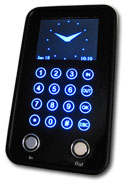(Read the newsletter containing this article.)
TimePilot timeclocks do a great job tracking the number of hours your employees work, but they can be quite useful for other tasks, too. Here are two examples:
Example 1
The Challenge:
Federal health and safety regulations require that Acme Company keep a record of the amount of time each employee spends in a particular work area. We’ll call it “Safety Room A.” There are two doors to Safety Room A, and employees can enter and leave by either one. The company had posted clipboards with “In Time” and “Out Time” sheets at each door, but they just weren’t doing the job. The company uses TimePilot Vetro clocks to track overall work hours, so employees carry their iButtons with them.
The Solution:
 Install a TimePilot Vetro clock at each of the two entrances to Safety Room A.
Install a TimePilot Vetro clock at each of the two entrances to Safety Room A.- The manager sets up a second company in the TimePilot Central software and calls it “Safety Room A.” He or she then assigns a second iButton—for this example we’ll choose red iButtons, but to avoid confusion they can be any color except black—to each employee who will be spending time in Safety Room A. (TimePilot sells iButtons in 10 colors besides basic black.)
- When an employee enters the work area, they’ll tap their red iButton to the Vetro clock at an entrance and when they leave that area they tap the red iButton to a Vetro at an exit.
- When data is collected from the Vetro clocks, it will be easy for supervisors to run reports from the “Safety Room A” company that will contain the employee’s name and exactly when her or she entered the room and left the room to satisfy federal regulations.
Example 2
The Challenge:
XYZ Grinding Co. has a precision surface grinding machine that needs to be lubricated after every 100 hours of use. The pencil-and-paper method of keeping track of the hours has been hit-or-miss, and XYZ Grinding needs more accuracy.
The Solution:
- XYZ attaches a TimePilot Tap+ timeclock to the machine with Velcro.
 A supervisor registers an iButton in TimePilot Central and assigns the iButton the name of the grinder (“Grinder No. 1”) and hangs the iButton next to the Tap+ clock.
A supervisor registers an iButton in TimePilot Central and assigns the iButton the name of the grinder (“Grinder No. 1”) and hangs the iButton next to the Tap+ clock.- The supervisor returns to TimePilot Central and sets the software to issue an alert when the grinder has been used for 95 hours. For more on alerts, see this article that appears in our August 2012 newsletter.
- The machine operator taps the iButton to the Tap clock’s “In” probe when the machine starts up and taps it to the “Out” probe when it stops.
- Every few days, the supervisor collects the data from the Tap clock. When the clock shows that usage has hit 95 hours, he or she starts planning a time to lubricate the machine.
Return to list of articles.


 Install a TimePilot Vetro clock at each of the two entrances to Safety Room A.
Install a TimePilot Vetro clock at each of the two entrances to Safety Room A. A supervisor registers an iButton in TimePilot Central and assigns the iButton the name of the grinder (“Grinder No. 1”) and hangs the iButton next to the Tap+ clock.
A supervisor registers an iButton in TimePilot Central and assigns the iButton the name of the grinder (“Grinder No. 1”) and hangs the iButton next to the Tap+ clock.